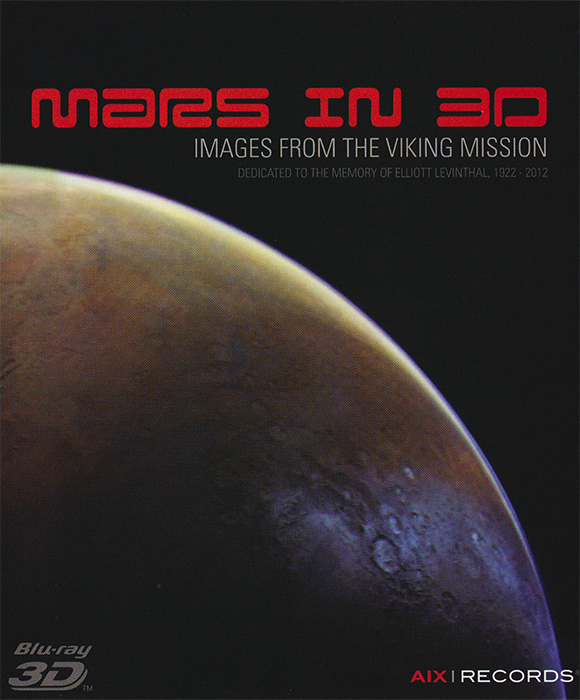Mars in 3-D is a stereographic film of imagery taken by the NASA Viking 1 and 2 orbiter and lander spacecraft between 1976 and 1979. The original 16mm film was produced at Stanford University by Dr. Elliott Levinthal in 1979. It is a unique overview of one of the United States' most important and successful space achievements of the decade following the Apollo moon program - the first spacecraft to land, return images, and search for signs of life on Mars.
Each spacecraft had both an orbiter and lander. Each lander had two cameras that together could produce 3D images. Their purpose was to triangulate distances to nearby features for programming the soil scoop arm, but they also proved useful in understanding the geology of the surrounding landscape. From orbit, pairs of images taken by the moving spacecraft from slightly different locations were used to produce the 3D images. The resulting exaggerated depth dramatically reveals the topography of the large-scale surface features. The film also includes stereo images of the Viking test lander taken at the Jet Propulsion Laboratory in Pasadena.
Watch now in HD with 5.1 surround audio!
This video requires a minimum internet connection speed of 12mbps. Use standard red/cyan 3D glasses to watch the anaglyph version. Connect, airplay, or cast the other versions to your 3D television or projector (Set the TV or projector to the appropriate 3D mode). All versions include a stereo-compatible 5.1 surround soundtrack
In 1979, Stanford's CCRMA was the leading center in the world for developing the use of computers for music. Dr. Levinthal approached founder and then-director Professor John Chowning for help in producing a soundtrack for the film. Prof. Chowning turned to two of his graduate students, myself and William Schottstaedt, and we each produced about 15 minutes of quadraphonic music for the film. This was an inspiring opportunity for me, having been an amateur astronomer since childhood and an avid supporter of the NASA manned and robotic exploration missions. In fact, astronomy was my original career goal.
Availability

Mars in 3-D is available on 3D Blu-Ray from AIX Records. It is also available as a 3D Digital Cinema Package (DCP) suitable for showing in commercial theaters or any digital cinema capable of 3D, using the industry standard CRU DX115 drive, or other media on request. Contact me for details.
You can also watch it above. The streamable 3D formats presented here are not full resolution, but you can download the full-resolution version (4.2GB, dual-1080p HEVC) playable from your computer using 3D player software.
Restoration Project
After being shown around the world at scientific conferences and concerts, the film reels and related materials were stored at the NASA archives at Ames Research Center in Mountain View, CA. In 2009, CCRMA proposed a concert including the Mars in 3-D film. Using 16mm projection with the original reels was out of the question due to the degraded quality of the film and soundtrack, and the outdated 16mm stereo technology. With the cooperation of NASA/Ames we began an effort to find, restore and convert the film to current theatrical format with 5.1 surround audio.
Copies of the 16mm reels, along with the original narration audio tapes, were located at NASA Ames and scanned to HD video. Extensive stabilization, noise reduction, damage repair, and color correction was performed in Final Cut Pro, using historical photographs and recent true-color mars imagery as a reference.
Several problems still remained. Stabilization had adversely affected the 3D alignment. There were inherent 3D fusion problems arising from the wide separation of the cameras. Some scenes had left and right images that were shot at different times of day, with differences in shadows and color. These problems made it difficult for some people to see 3D in some scenes even in the original movie. Using normal FCP tools to improve this proved highly impractical, so I employed the Stereo3D Toolbox plugin, graciously donated to the project by Dashwood Cinema Solutions.
The original quadraphonic surround music has been re-synthesized using a software emulator, written by Mr. Schottstaedt, that precisely reproduces the functionality of the hardware synthesizer we used in 1979, the Systems Concepts Digital Synthesizer, but with far higher audio quality. This, along with digitized copies of the original narration recordings, formed the basis of a new 5.1 surround soundtrack. You can hear a suite arranged from the soundtrack elsewhere on my site.